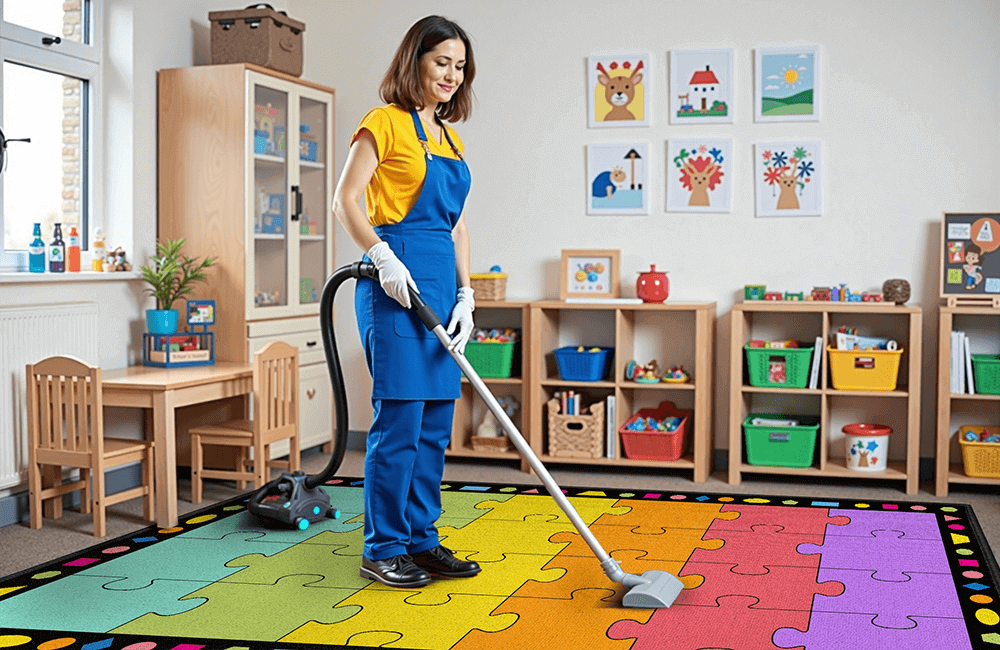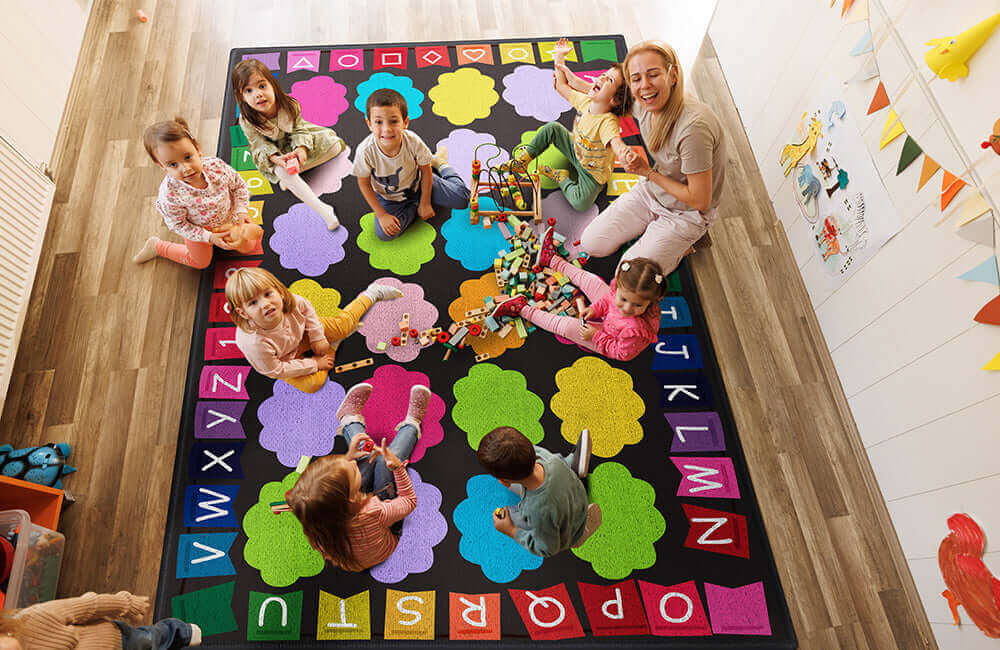The classroom rug—center of morning meetings, reading circles, collaborative projects, and countless learning moments—endures more foot traffic and potential contaminants than perhaps any other carpet in existence.
Beyond aesthetic concerns, maintaining classroom rugs directly impacts indoor air quality, student health, and the longevity of what is often a significant classroom investment.
While most educators recognize the importance of clean classroom rugs, many lack systematic approaches to maintenance that balance effectiveness with the practical constraints of busy school environments.
This comprehensive guide offers research-based strategies for incorporating carpet care into classroom routines throughout the academic year, ensuring your educational rugs remain vibrant, sanitary learning spaces.
Understanding Classroom Carpet Challenges
Classroom rugs face unique challenges that distinguish them from home or office carpeting:
High-Volume Traffic Patterns
Unlike residential carpets with varied use, classroom rugs experience:
- Concentrated foot traffic during transitions
- Multiple daily gathering sessions
- Heavy use during specific activities (centers, reading groups)
- Both seated and standing interactions
Diverse Contaminant Exposure
Classroom rugs regularly encounter:
- Outdoor debris from playground activities
- Art supplies (paint, glue, clay, markers)
- Food particles from snacks or lunch
- Biological contaminants during cold and flu seasons
According to a study published in Environmental Health, classroom carpets can harbor significant allergen loads, with researchers finding that "regular maintenance significantly reduced both dust accumulation and allergen levels, with impacts on both student attendance and comfort."
Maintenance Scheduling Constraints
Educators face unique cleaning challenges:
- Limited access outside school hours
- Rapid need for carpet drying before student return
- Restrictions on cleaning chemicals in educational settings
- Balancing maintenance with instructional priorities
Visit our Classroom Health Guide for more information on how carpet maintenance impacts overall classroom health.
Daily Maintenance Routines
Establishing consistent daily protocols prevents accumulation of debris that can damage carpet fibers:
End-of-Day Vacuuming
Implement a consistent:
- Systematic pattern covering high-traffic areas
- Special attention to gathering spaces
- Focus on entry points where debris concentrates
- Quick spot-check for visible materials
Immediate Response Protocol
Address spills and soiling through:
- Classroom "clean kit" for immediate response
- Blotting (never rubbing) of liquid spills
- Solid material removal prior to treatment
- Spot-treatment with appropriate solutions
Student Clean-Up Transitions
Incorporate carpet care into transitions:
- 30-second carpet checks before moving to new activities
- "Five things" pickup before leaving carpet areas
- Material containment expectations on carpeted areas
- Hand-cleaning protocols before carpet activities
The National Education Association's Health Information Network notes that "establishing daily maintenance routines not only extends carpet life but models environmental responsibility for students."
Weekly Cleaning Protocols
Weekly maintenance addresses deeper cleaning needs without disrupting instructional time:
Deep Vacuuming Procedures
Once weekly:
- Use multiple passes in different directions
- Access edges and corners often missed
- Apply carpet powder for odor control if needed
- Consider using vacuum with HEPA filtration
Spot Treatment Patrol
Dedicate time to:
- Assess entire carpet for missed spots
- Treat persistent stains before they set
- Address high-use areas showing soil buildup
- Document recurring problem areas for future prevention
Sanitizing Options
Consider weekly:
- Non-toxic sanitizing carpet powders before vacuuming
- UV sterilization wands for high-touch areas
- Microban or similar treatments for bacterial control
- Steam cleaning of small, heavily used sections
For suitable classroom-safe cleaning products, visit our Green Classroom Cleaning Guide.
Monthly Deep Cleaning Strategies
Monthly maintenance extends carpet life and addresses deeper hygiene needs:
Extraction Cleaning
Monthly extraction:
- Removes embedded particles vacuuming can't reach
- Eliminates residue from spot treatments
- Refreshes carpet fibers flattened by traffic
- Reduces allergen load significantly
Deodorizing Treatments
Consider monthly:
- Baking soda treatments (apply Friday, vacuum Monday)
- Enzyme cleaners for organic material breakdown
- Essential oil treatments (tea tree, lemon) for antimicrobial properties
- Circulation improvement through weekend air exchange
Rotation Considerations
When possible, monthly:
- Rotate rugs to distribute wear patterns
- Flip reversible carpets if appropriate
- Rearrange furniture to alter traffic patterns
- Document condition for comparison over time
According to Cleaning & Maintenance Management, "Monthly deep cleaning of classroom carpets shows measurable improvements in indoor air quality,
with particulate reduction of up to 50% compared to classrooms following only weekly protocols."
Vacation Break Maintenance Schedule
School breaks provide opportunities for more intensive maintenance without disrupting learning:
Fall Break Focus
Take advantage of October breaks for:
- Treating early-year art supply stains
- Addressing autumn allergens (pollen, leaf debris)
- Establishing baseline cleanliness for winter months
- Applying protective treatments before winter soiling
Winter Holiday Protocol
During longer December/January breaks:
- Schedule professional steam cleaning
- Apply antimicrobial treatments for cold/flu season
- Address salt or snow-melt chemical residue
- Conduct thorough drying in heated environments
Spring Break Refresher
Focus spring cleaning on:
- Pollen and environmental allergen removal
- Deep extraction of winter grime accumulation
- Spot treatment for persistent stains
- UV exposure if possible for natural sanitization
Summer Comprehensive Care
Utilize summer months for:
- Professional deep cleaning and extraction
- Complete drying with enhanced ventilation
- Repair of seams, binding, or damaged areas
- Protective treatments for the coming year
For a downloadable annual carpet maintenance calendar, visit our Classroom Organization Resources.
Addressing Common Classroom Spills
Different classroom materials require specific cleaning approaches:
Art Supply Response
For common art materials:
- Paint: Blot with clean cloth, treat with cool water and mild soap solution
- Glue: Allow to dry completely, then gently scrape and vacuum residue
- Clay: Let dry completely, break up, vacuum thoroughly, then treat residue
- Markers: Alcohol-based wipes for permanent markers, water for washable
Food and Drink Management
For typical classroom refreshments:
- Juice: Blot immediately, treat with 1:1 vinegar/water solution
- Crackers/Cookies: Remove solids, vacuum thoroughly, treat grease spots
- Yogurt: Remove excess, treat with enzyme cleaner to prevent odor
- Fruit: Address potential staining immediately with appropriate spot treatment
Biological Incident Protocol
For health-related accidents:
- Follow district biohazard protocols
- Wear appropriate protective equipment
- Use designated cleaning agents for bodily fluids
- Document incidents according to school policy
The American Academy of Pediatrics' School Health Guide emphasizes that "prompt, appropriate response to spills not only preserves carpet life but reduces disease transmission in classroom environments."
Student Involvement in Carpet Care
Engaging students in carpet maintenance teaches responsibility while distributing the workload:
Age-Appropriate Responsibilities
Consider assigning:
- PreK-K: Simple straightening of carpet edge, visual checking for items
- Grades 1-2: Specific roles in daily cleanup, reporting spills promptly
- Grades 3-5: Operation of stick vacuums, implementation of cleaning schedule
- Middle School: Analysis of carpet wear, research on maintenance improvements
Building Through Classroom Jobs
Integrate carpet care through:
- Rotating carpet monitor positions
- Clear visual instructions for job completion
- Recognition systems for careful maintenance
- Connecting care to broader environmental stewardship
Learning Connections
Link maintenance to curriculum through:
- Science connections to bacteria and hygiene
- Math applications in measuring cleaning solution ratios
- Writing procedures for proper carpet care
- Social studies discussions on shared responsibility
Education researcher Responsive Classroom notes that "student participation in classroom maintenance builds community investment while teaching practical life skills often missing from standard curriculum."
Our Student Leadership Guide offers additional frameworks for age-appropriate classroom responsibility systems.
When to Replace vs. Restore
Making informed decisions about carpet replacement preserves both budgets and environmental resources:
Condition Assessment Metrics
Evaluate carpets based on:
- Overall fiber condition and resilience
- Binding and edge integrity
- Persistent odor despite proper cleaning
- Stain percentage exceeding 20% of surface area
Restoration Options
Before replacement, consider:
- Professional recoloring of faded areas
- Binding repair or reinforcement
- Sectional replacement of damaged portions
- Deep extraction with professional equipment
Environmental and Budget Considerations
Balance decisions through:
- Cost comparison of restoration vs. replacement
- Environmental impact of carpet disposal
- Classroom disruption during replacement
- Future maintenance needs of potential replacements
According to Wikipedia's article on carpet maintenance, "professional restoration can extend carpet life by 3-5 years when underlying structural elements remain intact, representing significant budget and environmental savings."
For sustainable carpet options when replacement becomes necessary, visit our Eco-Friendly Classroom Guide.
Conclusion
Effective classroom carpet maintenance requires systematic approaches that balance thoroughness with practical constraints.
By implementing tiered care protocols—daily, weekly, monthly, and during breaks—educators can significantly extend carpet life while maintaining healthy learning environments.
Beyond the practical benefits of clean carpets, maintenance routines offer valuable opportunities to teach responsibility, environmental stewardship, and collective care for shared resources.
The modest time investment in establishing consistent maintenance systems returns dividends through extended carpet life, improved classroom health, and modeling of responsibility for students.
As you refine your classroom carpet care approach, remember that consistency rather than intensity yields the best long-term results.
Small daily actions, combined with strategic deeper cleaning during breaks, create learning environments where carpets enhance rather than detract from the educational experience.




Leave a comment
This site is protected by hCaptcha and the hCaptcha Privacy Policy and Terms of Service apply.